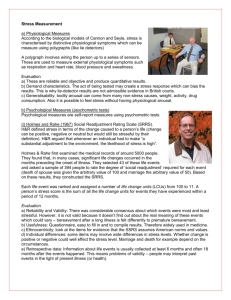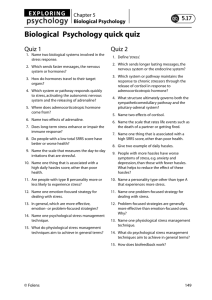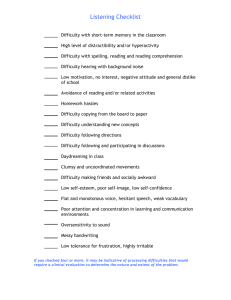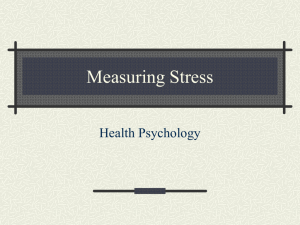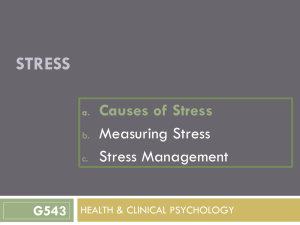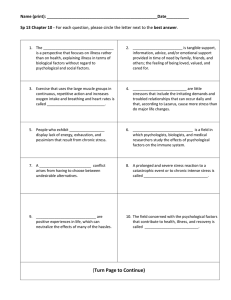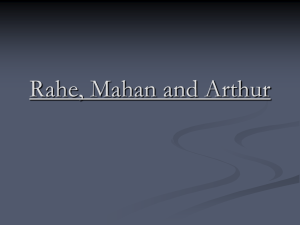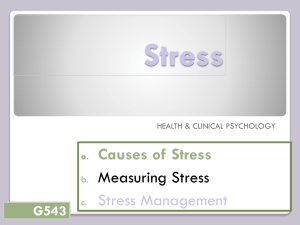StrssIncBioRET
advertisement
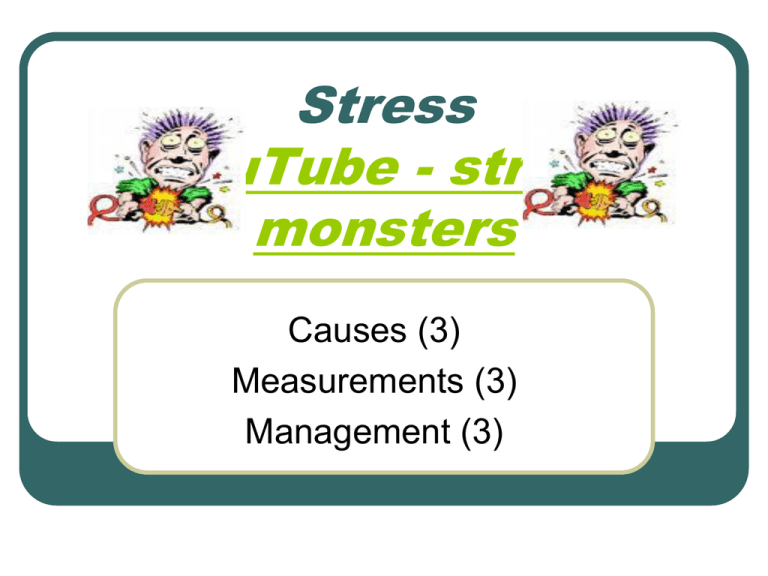
Stress YouTube - stress monsters Causes (3) Measurements (3) Management (3) Stress is a biological response to an external stressor/s Biological response to the fight or flight mechanism: The bodies stress response causes an increase in blood pressure, reduction in blood flow to the peripheral blood vessels (hand and feet) and an increase in adrenaline, noradrenalin and corticosteroids to be released into the blood stream. Over a long period of time this stress response causes the body’s immune systems to eventually break down. Why is understanding stress useful: 1. Causes psychological problems like anxiety and depression. 2. Causes everyday physical illness like cough and colds by lowering the effectiveness of the immune system. 3. Can cause heart disease and stroke by increasing build up of cholesterol. 4. May lead to illnesses like cancer 5. Causes millions of lost sick days from work 6. Causes accidents and injuries at work due to loss of concentration Evidence to show different factors which cause stress: Life event scales were devised to demonstrate how major life events such as death, divorce, unemployment and severe illness can be used to calculate levels of stress and consequently to predict illness (Holmes and Rahe 1967). However even when we do not have extreme stressors like these we still end up feeling stressed! Kanner 1981 - Minor stressors can combine to become large stressors: Psychological Measures (psychometric tests) (i) Holmes and Rahe (1967) Social Readjustment Rating Scale (SRRS). H&R defined stress in terms of the change caused to a person’s life (change can be positive, negative or neutral but would still be stressful by their definition). H&R argued that whenever an individual had to make “a substantial adjustment to the environment, the likelihood of stress is high”. Holmes & Rahe first examined the medical records of around 5000 people. They found that, in many cases, significant life changes occurred in the months preceding the onset of illness. They selected 43 of these life events and asked a sample of 394 people to rate the degree of ‘social readjustment’ required for each event (death of spouse was given the arbitrary value of 100 and marriage the arbitrary value of 50). Based on these results, they constructed the SRRS. Each life event was ranked and assigned a number of life change units (LCUs) from 100 to 11. A person’s stress score is the sum of all the life change units for events they have experienced within a period of 12 months. Examples of top rank events: The Social Readjustment Rating Scale (SRRS) RANK 1. Death of spouse 2. Divorce 3. Marital separation 4. Jail term 5. Death of close family member 6. Personal injury or illness 7. Fired at work 8. Retirement 9. Change in health of family member 10. Pregnancy 11. Sex difficulties 12. Gain of new family member Kanner Hassles and Uplifts Kanner used hassles as a predictor of stress and illness. The standard life events (SRRS) which had been popular previously to predict stress, was compared with relatively minor events, namely, the hassles and uplifts of everyday life. Hassles and Uplifts Scales were administered once a month for 10 consecutive months to a community sample of 100 middle-aged adults in California. A longitudinal study with repeated measures design was used as participants filled out both the Life Events Scale as well as the Hassles and Uplifts Scale. They then had their psychological symptoms of stress assessed using the Hopkins Symptom checklist and the Bradburn Morale scale. (Nine subjects dropped out) It was found that the Hassles Scale was a better predictor of psychological and physiological symptoms than were the life events scores. Hassles also seemed to be consistent month on month. Hassles and symptoms of stress were significantly correlated. The more hassles the participant reported the more symptoms they reported. Uplifts were positively related to reduced symptoms for women but not for men. It was concluded that the assessment of daily hassles and uplifts may be a better approach to the prediction of stress and ill health than the life events approach. Hassles and Uplifts - Kanner Daily Hassles Daily Uplifts 1 Concerns about weight 1 Relating well to spouse or partner 2 Health of a family member 2 Relating well to friends 3 Rising price of common goods 3 Completing a task 4 Home maintenance 4 Feeling healthy 5 Too many things to do 5 Getting enough sleep 6 Misplacing or losing things 6 Eating out 7 Outside home maintenance 7 Meeting your responsibilities 8 Property, investment or taxes 8 Visiting, phoning or writing to someone 9 Crime 9 Spending time with the family 10 Physical appearance 10 Finding your home a pleasant environment Work has also been shown to produce stress! What jobs or types of work would you think might be the most stressful? Johansson – Swedish Saw Mill Aim: to investigate whether work stressors such as repetitiveness, machine-regulated pace of work and high levels of responsibility increase stress-related physiological arousal and stress related illness Procedures: The researchers identified a high-risk group of 14 “finishers” in a Swedish sawmill. Their job was to finish off the wood at the last stage of processing timber. The work was machinepaced, isolated, very repetitive yet highly skilled, and the finishers’ productivity determined the wage rates for the entire factory The 14 “finishers” were compared with a low-risk group of 10 cleaners, whose work was more varied, largely self-paced, and allowed more socialising with other workers Levels of stress-related hormones (adrenaline and noradrenaline) in the urine were measured on work days and rest days Records were kept of stress-related illness and absenteeism Findings: The high-risk group of 14 finishers secreted more stress hormones (adrenaline and noradrenaline) on work days than on rest days, and higher levels than the control group. The high-risk group of finishers also showed significantly higher levels of stress-related illness such as headaches and higher levels of absenteeism than the low-risk group of cleaners. Conclusions: A combination of work stressors- especially repetitiveness, machine-pacing of work and high levels of responsibility – lead to chronic (long-term) physiological arousal. This in turn leads to stress-related illness and absenteeism. If employers want to reduce illness and absenteeism in their workforce, they need to find ways of reducing these work stressors, for example by introducing variety into employees’ work and by allowing them to experience some sense of control over the pace of their work. Johansson – Swedish Saw Mill – measures: Each participant had to give a urine sample four times a day so that their adrenal levels could be measured. Their body temperature was recorded at the same time as this can give an indication of how alert a person is. These two physiological measures were combined with self report where each participant had to say how much caffeine and nicotine they had consumed since the last urine test. They also had to report on a range of emotions and feelings as well as sleepiness, well-being, calmness, irritation and efficiency etc. They had to scale these feelings on a continuum from minimum to maximum using a scale with millimetres. The score was how many millimetres from the base point the participants had marked themselves to be feeling. This combined approach gave both qualitative and quantitative measurements enabling Johannson to compare the two groups of workers and understand the impact of higher stress levels on the participants. Stress on the job: Numerous studies show that job stress is far and away the major source of stress for American adults and that it has escalated progressively over the past few decades. Increased levels of job stress as assessed by the perception of having little control but lots of demands have been demonstrated to be associated with increased rates of heart attack, hypertension and other disorders. In New York, Los Angeles and other municipalities, the relationship between job stress and heart attacks is so well acknowledged, that any police officer who suffers a coronary event on or off the job is assumed to have a work related injury and is compensated accordingly (including a heart attack sustained while fishing on vacation or gambling in Las Vegas). Geer and Meisel: Stress and control: Aim: To see if perceived control or actual control can reduce stress reactions to averse stimuli. Method: Laboratory experiment in which participants were shown photographs of dead car crash victims and their stress levels were measured by GSR (Galvanic skin response) and heart rate through ECG monitoring. Participants: 60 undergraduates enrolled in a psychology course at a New York university. Design: Independent measures with participants randomly assigned to three conditions. Group 1: were given control over how long they looked at the images for. They could press a button to terminate the image and were told a tone would precede each new image. Group 2: Were warned the photos would be 60 seconds apart they would see the picture for 35 seconds and a 10 second warning tone would precede each photo. The group had no control but did know what was happening. Group 3: were told that from time to time they would see photos and hear tones but were not given timings or any control. Procedure: each participant was seated in a sound proofed room and wired up to the GSR and ECG machines. The machine was calibrated for 5 minutes while the participant relaxed and a baseline measurement was then taken. Instructions were read over an intercom. Each photo was precede with a 10 second tone and then flashed up for 35 seconds (only the one group could terminate the photo and move on). The GSR was taken at the onset of the tone and during the second half of the tone and in response to the picture. Results: ECG recordings were discarded as they appeared inaccurate. Group 2 showed most stress. Group 1 showed least stress. Conclusions: that having control over your environment can reduce stress responses. Causes of stress and supporting evidence: Work as a cause of stress: Johansson 1978 Swedish Sawmill, repetitiveness, machine pacing and responsibility. Hassles and Life Events as a cause of stress: Kanner 1981. Lack of control as a cause of stress: Geer and Meilsel 1973 lab experiment with car crash victims How can we measure stress levels? Physiological Blood pressure Steroid levels in urine and saliva (Reicher and Haslam). Galvanic skin response and heart rate (Geer and Meisel). Advantages scientific Disadvantages quantitative Self Report: We have already considered how stress can be measured – when looking at causes of stress by looking at Holmes and Rahe and Kanner with their Life Events and Hassles and Uplifts Scales. Advantages: qualitative and quantitative, detailed, personal. Disadvantages: time consuming, difficulty in analysing, experimenter bias Combined Approach to measuring stress: Johansson measured stress using biological measures and self report. This is a useful conclusion section when describing measurements as it involved both qualitative and quantitative data in the same measurements and reliability of the self report can be checked against the biological tests. Methods of measuring stress and supporting evidence: 1. Geer and Meisel 1973 – physiological -GSR (galvanic skins response) and heart rate, body temperature.YouTube - Stress Monitor 2. Kanner – self report of hassles and uplifts. Holmes and Rahe – self report of major life events. 3. Johansson 1978 – combined approach using physiological - urine tests and self report. Validity and measurements It is possible that a question could arise which is entirely about validity – the most common way in which this is usually addressed is when the area specifically looks at measurements – as validity obviously means are we measuring what we say we are measuring! Discuss the validity of measurements of stress (15) Techniques of stress management Learning Objectives: Understand and evaluate behavioural and cognitive techniques to stress management. Explain the use of stress management techniques What techniques can be used to manage stress: Cognitive techniques (SIT) – Stress Inoculation Therapy: can be used to help people learn to identify when they will become stressed and use positive thoughts to try and reduce future stress responses during sessions of cognitive therapy. Michenbaum (1975)YouTube Stress Reduction 1 of 6 http://www.youtube.com/watch?v=UGaRyLN9gb8 RET: Rational emotive therapy Page: 162 Developed by Ellis 1962. Ellis believed that faulty or irrational ways of thinking affect stress appraisal processes & increase the appraisal of threat or harm. RET A-B-C-D-E framework whereby the therapist bluntly/aggressively challenges the client to examine their belief systems to realise how irrational and damaging they are. Copy table 2 into your notes! Once completed summarise the evaluation in your own words. Meichenbaum Stress Inoculation Therapy - Cognitive Standard behavioural measures have tried to help people become desensitised to stress. Meichenbaum compared these standard behavioural methods with cognitive ones. Cognitive therapy sessions aimed at enabling people to identify their stressors and change their mental processes when under stress rather than just their behaviours. 21 students ages 17 – 25 responded to an advert about treatment of test anxiety. It was a field experiment with participants put into three groups, SIT, standard desensitisation and a control group. Each participant was tested using a test anxiety questionnaire. The SIT group received 8 therapy sessions giving them insight into their thoughts before tests. They were then given some positive statements to say and relaxation techniques to use in test situations. The systematic desensitisation groups were also given 8 therapy sessions with only progressive relaxation training whilst imaging stressful situations. The control group were told they were on a waiting list for treatment. Findings: performance in tests in the SIT group improved the most although both therapy groups showed improvement over the control groups. Conclusions: that SIT is an effective way of reducing anxiety in students who are prone to anxiety in test situations and more effective than simply behavioural techniques when a cognitive component is added in. Past Exam Question: Discuss the cognitive approach to managing stress. Refer to one other approach in your answer. 12 marks Behavioural techniques – biofeedback: Allowing people to monitor their own health and gain feedback about the effects of certain behaviours allows them to modify behaviour through positive reinforcement. Budzynski (1973)YouTube - Stress Management and Temperature Bio Feedback http://www.youtube.com/watch?v=ZBY1YdwEfNQ YouTube - How to Use Biofeedback for Stress http://www.youtube.com/watch?v=kn1RHEcmrNI YouTube - breathing techniques for stress, anxiety and panic Behavioural techniques – Biofeedback - Budzinski Aim: to see if biofeedback techniques work and help reduce tension headaches or whether the effect is due to the placebo effect. The placebo effect is a positive psychological effect that can occur even when there is no actual treatment. Method: Experimental method with patients trained in the laboratory. Data was collected using muscle tension measurements (EMG) with an electromyography, a machine which gives feedback by a graph by applying electrodes to the muscles. Patients were also given a psychometric test for depression (MMPI) and asked to complete questionnaires on their headaches. It was an independent measures design with participants randomly assigned to one of three groups. Participants: 18 replied to a newspaper advert in the USA. They were screened by telephone and then had psychiatric and medical examinations to ensure there were no other reasons for their headaches. There were 2 males and 16 females aged 22-44 with a mean age of 36. Group A had real biofeedback training with relaxation using the EMG Group B had biofeedback training but with false (pseudo) feedback Group C were used as a control group Procedure: all groups kept a diary of their headaches for two weeks, rating them from 0 mild to 5 severe. Groups A and B were told to practice relaxation after the training for 15 – 20 mins each day. Results : After 3 months group A’s muscle tension was significantly lower than the other two groups. Reporting of headaches in group A also fell significantly compared to their base line which it did not in the other two groups. Conclusions: biofeedback is an effective way to reduce stress levels by reducing tension. Social approaches: Many researchers have found out that social support helps reduce stress. Loneliness and isolation increase stress. Waxler- Morrison (2006) found women with strong social relationships were more likely to survive breast cancer! Waxler-Morrison – Social Support Aim: to look at how a woman’s social relationships influence her response to breast cancer and survival. Method: a quasi experiment with woman who were diagnosed with breast cancer. The information was gathered using questionnaires and 18 interviews plus examination of medical records. Women were fitted into categories based on their social support network. Participants: 133 women under 55 yrs (pre-menopausal) who had been referred with breast cancer in Canada. Design: Independent measures design with women of different pre existing levels of social support. Procedure: women were sent a questionnaire to fill in about their social support including questions on education and family responsibilities, friends, their perception of their support from others, marital status and church memberships etc. Their diagnoses were taken from medical records which were again checked 4 years later. Findings and conclusions : qualitative data from questionnaires showed that practical help given by others for cleaning, child care, cooking etc was essential for support. Jobs were seen as important for support and most survivors reported supportive husbands although problems were often reported with children who may also need support. There was a significant relationship between the amount of support reported and survival rates. Techniques for managing stress and supporting research: 1. Cognitive techniques – Michenbaum 1975 2. Behavioural techniques – biofeedback – Budzynski 1973 3. Social support – Waxler-Morrison 2006 Problems and usefulness Due to the high rate of illness and days off work sick combined with an increasingly stressful society it is really useful to learn how to manage our stress and avoid long term ill health. We have already seen how lack of control causes stress (Geer and Meisel) – so by giving back control through cognitive or behavioural measures it can only help reduce stress However – stress management needs trained counsellors, resources, commitment, time, money, and possibly a level of understanding that not everyone will be able to show. Some strategies are also more appropriate for long term stress rather than short term. For example if bereavement causes stress then cognitive therapy is not the answer – social support might be most appropriate – if there is a longer term problem social support may be a good first option followed by cognitive or behaviour therapy etc. Exam questions: For Home Work!!Due 24/11/10 Outline one technique for managing stress (10) Describe and evaluate the role of social support in mediating responses to stress. Refer to evidence in your answer.(12)
